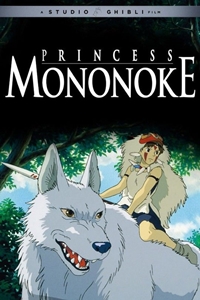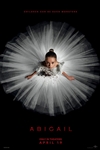Princess Mononoke (Mononoke-hime) () ★★½
 In the United States, when one speaks of animation, two things almost immediately spring to mind: Disney features and Saturday morning cartoons. While there have been flashes of brilliance from the former (''Beauty and the Beast''), the latter is hardly known for its innovation.
In the United States, when one speaks of animation, two things almost immediately spring to mind: Disney features and Saturday morning cartoons. While there have been flashes of brilliance from the former (''Beauty and the Beast''), the latter is hardly known for its innovation.
Since the 1980s, there has been a growing appreciation among aficionados of Japanese anime (animated films) and manga (comic books). The preeminent master of anime is Hayao Miyazaki, who may not be all that familiar to American audiences -- yet. With the release of his masterpiece, ''Princess Mononoke,'' that should change. In the early 1970s, Miyazaki conceived ''Princess Mononoke'' as a riff on ''Beauty and the Beast,'' but he abandoned that project. Nearly 20 years later, he returned to the idea, fleshing it out as a cautionary ecological fable that draws on Japanese mythology. Miyazaki and his team spent nearly four years creating this delicately nuanced, beautifully rendered film which, upon its 1997 release, became the second-highest grossing film in Japan after ''Titanic.''
Miramax (perhaps ironically now a division of Disney) purchased the U.S. distribution rights and spent a great deal of time and money re-dubbing the dialogue in English with an all-star cast. While perhaps some of Miyazki's ideas may have been lost in the translation, the visual beauty has been preserved. (Most of the cels in the film were hand-drawn and colored and the textures and vibrancy shimmer in each frame.)
Unlike Disney features which generally follow familiar fairy tales or stories and feature song scores and cute anthropomorphic sidekicks, ''Princess Mononoke'' is more straightforward. Set in 14th-century feudal Japan, it tells of the warrior Ashitaka (voiced by Billy Crudup) who is wounded when battling a demon-god boar and becomes cursed. Forced to leave his homeland, he travels westward in search of the source of a metal ball found imbedded in the boar and in the hopes of finding a cure for his affliction. What he finds instead is a fortress where iron is manufactured. Run by the coldly efficient Lady Eboshi (Minnie Driver), the operation threatens the delicate balance of nature through deforestation and by spewing pollutants into nearby streams. On the other hand, Eboshi employs workers who are societal outcasts like lepers and prostitutes, offering them a certain amount of dignity.
Ashitaka also encounters the titular character, San (Claire Danes), who has been raised by wolves and has sworn to destroy the humans who show disrespect for the world around them.
Miyazaki has gone to great lengths not to draw the characters as villains or heroes, but rather each character has traits that are both positive and negative. He posits a world where dilemmas exist, where violence coexists with the wonders of nature, where good and evil dwell equally in all creatures.
For the most part the script translation by Neil Gaiman is smooth and the vocal talent (with the exception of Danes' flat line readings) more than adequate. Gillian Anderson as San's adoptive mother is outstanding. Some scenes in the film are gory and may scare young children, but older teens and adults should revel in the beautifully realized scenery and the rich characters.
* MPAA rating: PG-13, for images of violence and gore.
'Princess Mononoke'
Gillian Anderson: Moro
Billy Crudup: Ashitaka
Claire Danes: San
Minnie Driver: Lady Eboshi
Billy Bob Thornton: Jigo
Jada Pinkett Smith: Toki
Tokuma Shoten Nippon Television Network, Dentsu & Studio Ghibli present a Studio Ghibli production, released by Miramax Films. Director Hayao Miyazaki. Producer Toshio Suzuki. Executive producers Yasuyoshi Tokuma, Bob Weinstein, Harvey Weinstein, Scott Martin. Screenplay Hayao Miyazaki. English-language adaptation Neil Gaiman. Editor Takeshi Seyama. Music Joe Hisaishi. Running time: 2 hours, 13 minutes.
To get the full Quicklook Films experience, uncheck "Enable on this Site" from Adblock Plus
box office top 10

Challengers Released: April 26, 2024 Cast: Zendaya, Josh O'Connor 15M

Unsung Hero Released: April 26, 2024 Cast: Daisy Betts, Joel Smallbone 7.8M

Godzilla x Kong: The New Empire Released: March 29, 2024 Cast: Rebecca Hall, Brian Tyree Henry 7.2M

Civil War Released: April 12, 2024 Cast: Kirsten Dunst, Wagner Moura 7M

Abigail Released: April 19, 2024 Cast: Melissa Barrera, Dan Stevens 5.3M

The Ministry of Ungentlemanly Warfare Released: April 19, 2024 Cast: Henry Cavill, Eiza Gonzalez 3.9M

Kung Fu Panda 4 Released: March 8, 2024 Cast: Jack Black, Viola Davis 3.6M

Ghostbusters: Frozen Empire Released: March 22, 2024 Cast: Paul Rudd, Carrie Coon 3.3M

Dune: Part Two Released: March 1, 2024 Cast: Timothée Chalamet, Rebecca Ferguson 2M

Boy Kills World Released: April 26, 2024 Cast: Bill Skarsgård, Famke Janssen 1.7M






